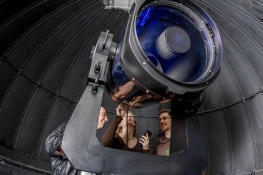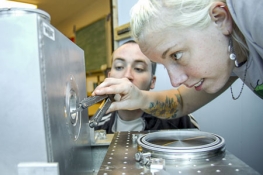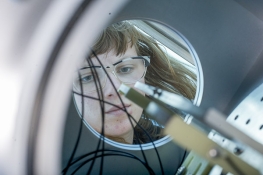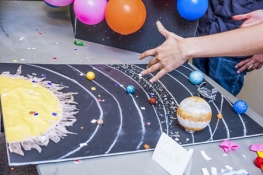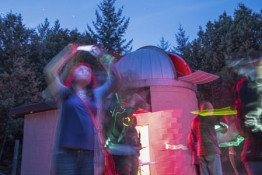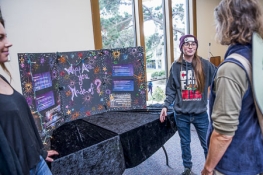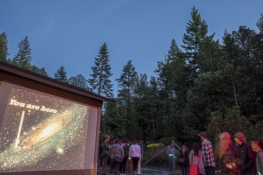Gravitational Research Laboratory
Location: Science A - Room 264
Phone: 707-826-4981
Principal Investigator: C.D. Hoyle, 707-826-3235
Primary Research Areas
- Short-range tests of Newton's 1/r² law and the Weak Equivalence Principle
- Searches for new fundamental forces
- Investigation of the mechanism behind Dark Energy
- Measurement of the Newtonian Gravitational Constant, G
- Collaboration on the development of novel gravity gradiometers utilizing atomic clocks and cold-atom interferometry
Collaborations
- Torsion Pendulum tests of gravity with the Eöt-Wash group at the University of Washington. This group’s leaders won the 2021 Breakthrough Prize in Fundamental Physics.
- Development of a new experiment to measure the gravitational constant with Professor Ricardo Decca at Indiana University, Indianapolis (IUI).
- Development of the LAG experiment to test gravity at short distances in collaboration with Dr. Luciano Di Fiore of the INFN (Italian Institute of Nuclear Physics) and Dr. Rosario De Rosa of the University of Naples Federico II (Italy).
- Collaboration with Dr. Holly Leopardi of the NASA Goddard Space Flight Center QuEST Laboratory on the development of novel quantum sensors for measuring minute variations in gravitational fields from space.
Overview
After over 300 years of experimentation, the true nature and implications of gravity are not fully understood. Here at Humboldt, we are creating a laboratory to investigate the subtle properties of this familiar force of nature via a variety of experimental efforts.
Gravity and quantum mechanics are fundamentally inconsistent in the current frameworks of the Standard Model and General Relativity. String theory promises a possible resolution of this issue at the cost of introducing new spatial dimensions (Arkani-Hamed, et al.). These dimensions will necessarily alter the Newtonian inverse-square law on distance scales similar to that of the size of these extra dimensions.
The Newtonian Gravitational constant, G, is the oldest of the known fundamental constants; however, it remains the one known with the least precision (the uncertainty in G has only improved by about one order of magnitude per century since its first measurement in 1798). Moreover, recent measurements show a large variation in values. We are working on a new experiment to help resolve these issues in collaboration with Dr. Ricardo Decca at IUI.
Quantum sensors will provide entirely new techniques to map the Earth's gravitational field to study ice and water flows from space. These sensors will also enable precision fundamental physics measurements and provide next-generation navigation systems for future spacecraft. We are collaborating with Dr. Holly Leopardi at NASA's Goddard Space Flight Center so that our students can be involved with this cutting-edge research.
Gravity Lab in the News
- Cal Poly Humboldt Researcher Collaborates with NASA on Novel Gravity Gradiometers
- Cal Poly Humboldt Students Excel at Student Research Competition
- Chasing Particles at the World’s Largest Lab
- Gravity Lab Students Honored for a Top Presentation at IdeaFest
- Gravity Lab researcher Holly Leopardi named Outstanding Student of the Year
- Hands-On Research Attracts Students to Gravity Lab
- Searching for Gravity’s True Nature
- Students Put Einstein Theory to Toughest Test Yet
Presentations & Publications
Recently published peer-reviewed articles (*indicates undergraduate authors):
"Optimization of an Active Leveling Scheme for a Short-Range Gravity Experiment,"
Alyssa Johnson*, Claire Rogers*, Noah Dunkley*, Michael Gengo*, and C.D. Hoyle, Journal of Undergraduate Reports in Physics (JURP) 33, 100002 (2023)
https://doi.org/10.1063/10.0022466
"Measurement of gravitational and thermal effects in a liquid-actuated torsion pendulum," A. Allocca, M. Bassan, M. De Laurentis, R. De Rosa, L. Di Fiore, L. D’Onofrio, L. Errico, F. Garufi, A. Grado, C.D. Hoyle, D. Lucchesi, Y. Minenkov, G. Passeggio, G. Pucacco, V. Sequino, O. Tarallo, L. Trozzo, and M. Visco, Rev. Sci. Instrum. 94, 114501 (2023)
https://doi.org/10.1063/5.0162604
"Fifteen Years of Millimeter Accuracy Lunar Laser Ranging with APOLLO: Data Set Characterization," J.B.R. Battat1, E. Adelberger, N.R. Colmenares, M. Farrah, D.P. Gonzales, C.D. Hoyle, R.J. McMillan, T.W. Murphy Jr., S. Sabhlok, and C.W. Stubbs, Publications of the Astronomical Society of the Pacific 135, 1052 (2023)
https://doi.org/10.1088/1538-3873/aceb2f
"A modified Michelson interferometer to measure sub-milliradian changes in angle," C.K. LeDesma*, M.P. Ross*, B.E. Daly*, C.D. Hoyle, and M.M. Mola, AIP Advances 12, 085002 (2022)
https://doi.org/10.1063/5.0100720
Students and faculty who work in the gravity lab have given more than 35 presentations at regional and national meetings, including those of the American Physical Society, National Conference on Undergraduate Research, and the Pacific Coast Gravity Meeting, to name a few. The lab has published peer-reviewed work in undergraduate research journals and we have several publications currently in the pipeline!
Support
The material on this site is based upon work supported by the National Science Foundation grants PHY-1065697, PHY-1306783, PHY-1606988, PHY-1708024, PHY-1908502, and PHY-2207801, NASA MOSAICS grant 80NSSC24K1063, as well as the Gordon and Betty Moore Foundation Grant GBMF6210 to the American Physical Society. We are also grateful for financial support provided by the Cal Poly Humboldt College of Natural Resources and Sciences, Sponsored Programs Foundation, and Research Corporation grant CC6839.
Any opinions, findings, and conclusions or recommendations expressed in this material are those of the author(s) and do not necessarily reflect the views of the National Science Foundation or the National Aeronautics and Space Administration.

